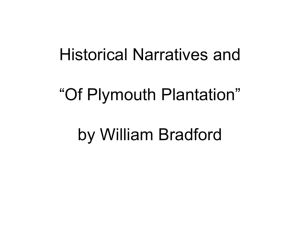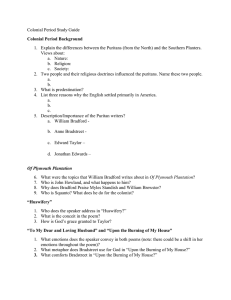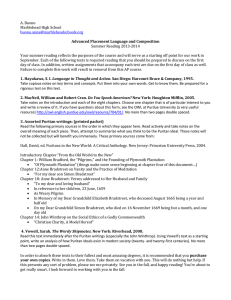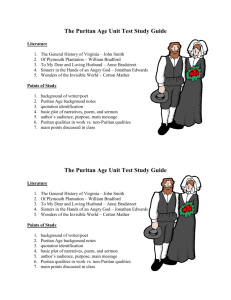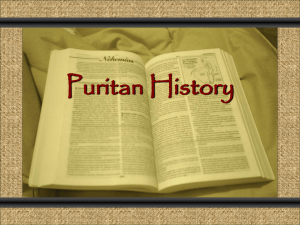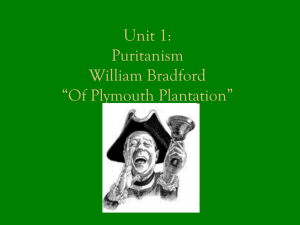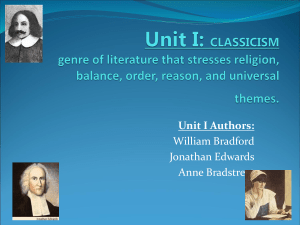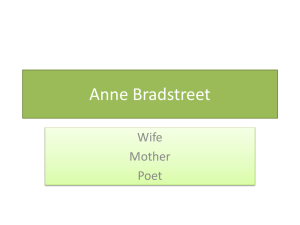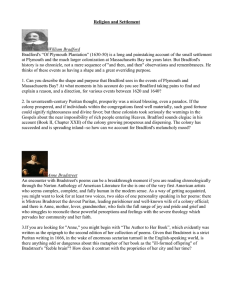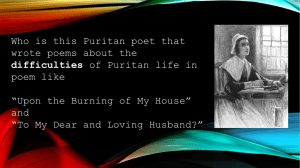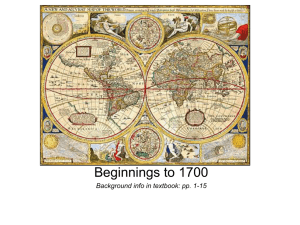pilgrims and puritans
advertisement
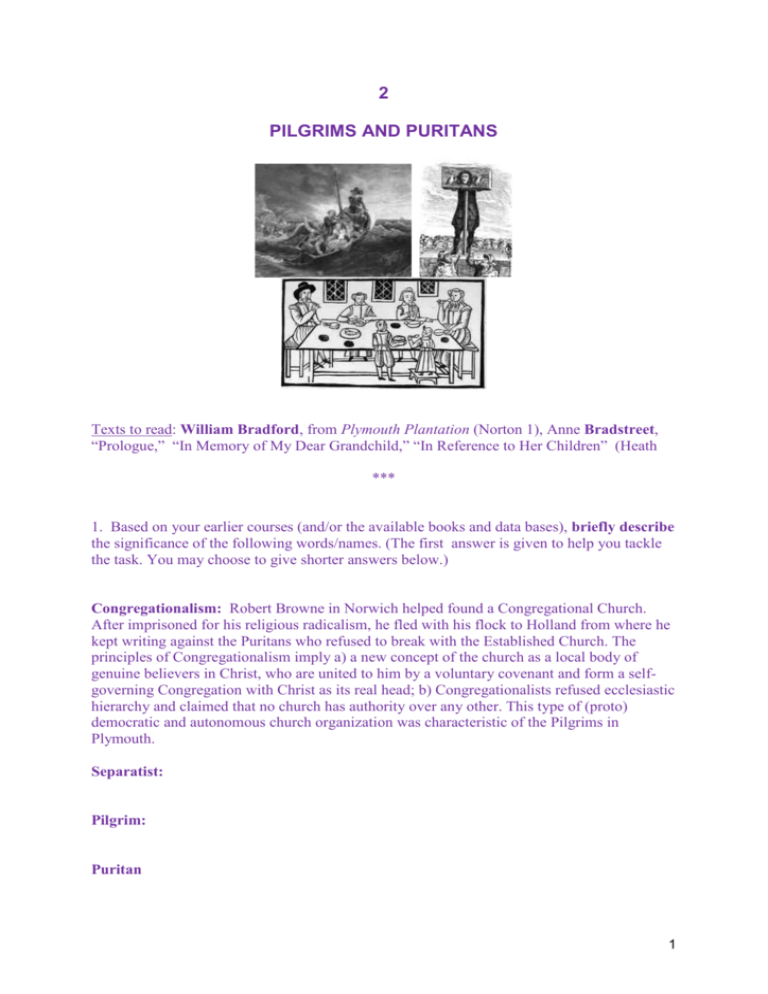
2 PILGRIMS AND PURITANS Texts to read: William Bradford, from Plymouth Plantation (Norton 1), Anne Bradstreet, “Prologue,” “In Memory of My Dear Grandchild,” “In Reference to Her Children” (Heath *** 1. Based on your earlier courses (and/or the available books and data bases), briefly describe the significance of the following words/names. (The first answer is given to help you tackle the task. You may choose to give shorter answers below.) Congregationalism: Robert Browne in Norwich helped found a Congregational Church. After imprisoned for his religious radicalism, he fled with his flock to Holland from where he kept writing against the Puritans who refused to break with the Established Church. The principles of Congregationalism imply a) a new concept of the church as a local body of genuine believers in Christ, who are united to him by a voluntary covenant and form a selfgoverning Congregation with Christ as its real head; b) Congregationalists refused ecclesiastic hierarchy and claimed that no church has authority over any other. This type of (proto) democratic and autonomous church organization was characteristic of the Pilgrims in Plymouth. Separatist: Pilgrim: Puritan 1 Covenant: Mayflower: Arbella: Plymouth: Massachusetts Bay Company Massachusetts Bay: New Amsterdam: Rhode Island: “The Mayflower Compact”: “A Model of Christian Charity“: Antinomians: Seekers: Quakers: Harvard College: Captivity narrative: American Jeremiad: 2 Diary: Sermon: Puritan typology or Puritan reading of the world: Grace: Confession—conversion experience: Meetinghouse: Saint Elect 2. What one title of a major work do you relate to each of these famous intellectuals? John Winthrop: William Bradford: John Cotton: Samuel Sewall: Cotton Mather: John Wigglesworth: Edward Taylor: 3. In religion, the Puritan colonists were heirs of both the Reformation and of medieval Christianity. Above all, it was John Calvin’s famous Five Points, seeking a more radical purification of theology and the structure of the Catholic Church than Luther’s 95 Theses (posted on the door of the castle church at Wittenberg in 1517), that were instrumental in shaping the life of American colonists in the north-east. After reading these five Calvinist (corresponding with the Puritan) doctrines below, write a few defining sentences for the lesser informed the meaning of which you are requested to elucidate. a) Total depravity: 3 b) Unconditional election: c) Limited Atonement: d) Irresistible grace (irresistible nature of God’s grace): e) Perseverance of the Saints: 4. Study this gravestone (the Joseph Tapping stone) from 1678 erected in King’s Chapel, Boston. What are the emblems carved into stone and their implications established by Puritan tradition? How do you interpret the meaning of these emblems in the context of the puritan belief system? List 1. Winged skull: Interpretation 4 5. In Book I, Chapter IX (Norton 1, 59-62 OR http://liternet.bg/publish21/w_bradford/01_09.htm ) of Of Plymouth Plantation, William Bradford simultaneously represents the Pilgrims as a people of circumference and of the center by using Biblical parallels to enhance the significance of their voyage to America (center) and also stressing the unparalleled fears and doubts involved in this voyage (circumference). Read the excerpt and describe the nature of this “archetypal” American paradox voiced by Bradford. Focus on the last two paragraphs (pp 61-2), beginning with “But here I cannot but say. . .,” and think about the implications of the following: Passed the vast ocean, and a sea of troubles And for the season it was winter. . . hideous and desolate wilderness. . . Neither could they, as it were, go up to the top of Pisgah. . . If they looked behind them, there was the mighty ocean which they had passed and was now as a main bar and gulf to separate them from all the civil parts of the world He had delivered them from the hand of the oppressor 5 6. This is a reconstruction of Leyden Street, in the Plymouth Plantation, in the 1620s, which gives you a glimpse of everyday life in the early American colony. Englishmen and women carried with them the institutions of public and private life, the systems of laws and customs, the houses in which families lived, the clothes they wore, and the language they spoke in the Old World. What do you think were the main crafts and skills that these early 17th-century settlers must have had to survive the hardships of starting anew in a foreign land? 6 7. In John Winthrop’s journal, a sarcastic passage dealing with a governor’s wife who loved reading books suggests the general sentiment among Puritans about women’s intellectual “inferiority.” As Winthrop claimed: If she had attended her household affairs, and such things as belong to women, and not gone out of her way and calling to meddle in such things as are proper for men whose minds are stronger, etc, she had kept her wits, and might have improved them usefully and honorably in the place God had set her. It was against this backdrop of ridicule, denial and subordination that Anne Bradstreet wrote her poems (later to be published in London in 1650, as the first book of poetry from New England). In the Prologue of her The Tenth Muse, Lately Sprung Up In America, Bradstreet gives voice to her awareness of the hostility that she as a woman poet evoked in her contemporaries. This stained-glass tributary portrait of Anne Bradstreet is part of a window in Saint Botolph’s Church, Boston, Lincolnshire, England. a) Read the Prologue in Heath 1 or at http://www.annebradstreet.com/prologue.htm What are the charges leveled against her as a woman writer? Are they different from Winthrop’s? Do you think this unfriendly attitude toward women writers or women philosophers or female politicians is still perceptable today? 7 b) Read “In Memory of My Dear Grandchild Elizabeth Bradstreet…” http://www.poetrycat.com/anne-bradstreet/in-memory-of-my-dear-grandchildanne-bradstreet-who-deceased-june-20-1699-being-three-years-and-seven-monthsold#.U_-e4_njXPo and copy the first stanza here, indicating the kinds of feet that make it up. Also, give the name of the type of line she uses in this poem. c) In stanza two there is an opposition that the dramatic tension of the poem hinges on. Rephrase it in your own words, considering God’s part in this tragedy. 8

